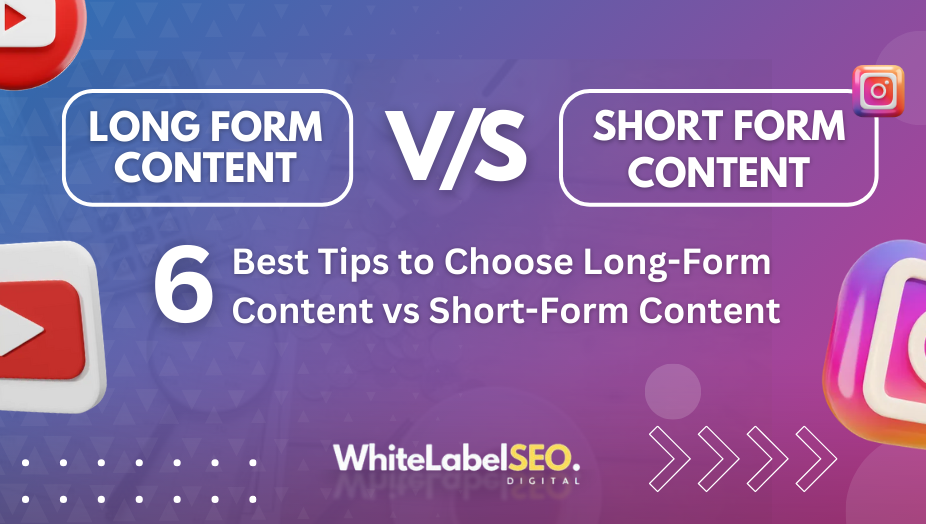
While long-form content helps establish your brand and offers valuable information to your audience, short-form content is essential for grabbing their attention when they don’t have time for a lengthy read. Balancing long form content vs short form content keeps your audience engaged. But how do you know when to use each type? In this article, I’ll discuss when to use each, the benefits of both, and best practices for creating long and short-form content.
Short-Form Content vs. Long-Form Content: Main Differences

What is Long-form Content?
Long form content includes any written content over 1,200 word count. This type of content allows for a deeper discussion on a topic, providing readers with a thorough understanding. It offers high-quality information supported by research and data when necessary.
Long form content is ideal for readers who have more time and want detailed information beyond a quick listicle. It engages audiences differently compared to short form content. Short form content can use humor to quickly capture attention and entertain, while long form content engages by providing valuable, detailed information that readers can use for their own business or personal goals.
Incorporating both types into your content strategy ensures you meet the diverse needs of your target audience. Each type of content may be more suitable depending on the context and the search engine algorithms that prioritize different content lengths for various queries.
Long-form content formats include the following:
Blog posts
Guides and Tutorials
White papers and eBooks
Webinars and Virtual Events
Pillar pages
What is Short Form Content?
Short-form content includes any written content under 1,200 words and short-form video content less than 10 minutes long. This type of content is quick and easy for your audience to digest, making it perfect for sharing news and important information they need to remember.
Creating short-form content is about selecting the best content on your chosen topic and presenting it in bite-sized segments. This approach helps your target audience engage with your brand and positions you as an industry expert. Using shorter content, such as short-form pieces, can effectively capture attention and convey key messages efficiently.
Examples of short-form content include:
Blog posts
News articles
Emails
Infographics
Social content like TikTok videos, Instagram posts, and memes
Long Form Content Vs Short Form Content: Pros and Cons

Pros and Cons to Use Long-Form Content
Some of the main benefits of long-form content are:
- It stands a better chance of getting keyword rankings that boost visibility in search engines.
- It tends to earn more backlinks (links on other websites that point to your website), which can improve your SEO.
- It often stays relevant and attracts traffic and engagement for longer periods.
- It can be reworked and shared on other platforms, giving you more value for your effort.
- It helps to position you as a thought leader in your industry, especially when it includes original research and insights.
However, long-form content has some downsides:
- It often takes more time and resources to produce.
- It doesn’t always display properly on mobile devices, which can impact user experience and SEO.
- It might overwhelm or discourage people who prefer snackable content.
- It doesn’t always garner as much engagement or inspire action.
Also Read: How to Do SEO Content Writing That Ranks in 2024
When considering long form content vs short form content, it’s important to balance both types in your content creation strategy. Long-form video content and articles can enhance your keyword rankings and audience engagement, while shorter pieces keep your audience engaged and coming back for more.
5 Quick Tips to Improve Your Long Form of Content

Long-form content can deliver great results, but it requires time and research. Before you publish, use these strategies to prepare your work for success.
Be succinct. Long-form content allows for detailed explanations, but avoid fluff or rambling. Focus on specific questions you plan to answer and strategies to guide readers to the next piece of content. This approach helps content creators keep their audience engaged.
Make it skimmable and searchable. Use structural elements like headers, a table of contents, and properly formatted links to ensure easy navigation in long-form content. Without these, visitors may lose interest or their place in the content. These steps also help earn Featured Snippet placements on Google SERPs.
Space out content with engaging images. Visual elements like product images, stock photos, videos, graphs, and charts are important for long-form content. They communicate complex concepts quickly and give readers breaks. These images can also lead to higher conversions, making your detailed content more engaging and effective.
Expand on winning content. When creating long-form content, start by expanding on successful content you’ve already made. For example, if a 300-word infographic is popular, create a long-form article on the topic or focus on one section of data. Just ensure you don’t cannibalize your own work. Long-form content allows you to dive deeper into topics that resonate with your audience.
Preview posts on mobile devices. Always check how long posts look on different screens. Use a mobile-optimized platform to publish content and preview your posts on mobile devices. Many content management platforms, like HubSpot and Mailchimp, offer this feature. This ensures your content is more likely to be user-friendly across all devices.
By following these strategies, content creators can effectively balance long form content vs short form content, making their detailed content both engaging and accessible.
Pros and Cons to Use Short-Form Content
Some of the best reasons to use short-form content are that it’s:
- Easier for users to consume
- Typically mobile-friendly
- Less resource-intensive to produce and easier to scale compared to long-form content
- Sharable due to its brief and often punchy nature
However, short-form content has some downsides:
- It doesn’t allow you to cover a topic in-depth, which can lead to oversimplification or skipping key details
- It can easily start to seem repetitive if it’s not produced with a well-planned strategy
- It often has a shorter shelf life than evergreen content, so its relevance can fade quickly
- It might not establish your authority as well as long-form content, given the limited space
When comparing long form content vs short form content, each piece of content serves a different purpose. Short-form content is great for quick, mobile-friendly updates and shares, while longer content allows for more in-depth insight and comprehensive coverage of a topic. Balancing both types can enhance your content strategy.
5 Quick Tips to Improve Your Short-Form Content
To grow audience engagement, mastering short-form content is essential. With less time to make an impact, every word counts. Use these best practices to enhance your work and avoid common mistakes.
Be as detailed as possible: Even though people know they’re engaging with a shorter piece of short-form content, they still expect a complete answer, whether it’s a product page or social media shout-out. This is crucial for any digital marketing strategy.
Stand out with unique info and insights: Short-form content is a crowded field. You’ll cover the same ideas and answer the same questions as your competitors, but you can set your work apart with unique data, interviews, metrics, and more. This applies to all types of short-form content, including short blog posts.
Offer resources for further reading: Link to other rich content, internal or external. If you’re writing about how to start a business and don’t have existing content on business marketing, link to a reputable source. It’s all about supporting your audience with actionable tips and providing a well-rounded digital marketing strategy.
Have a thoughtful internal linking strategy: When you plan any piece of content, think of the internal links you want to include. This not only piques your audience’s interest but also strengthens your overall content, blending both long form content vs short form content effectively.
Merge underperforming posts into one long post: Sometimes the best way to revitalize weak or thin content is to combine it into a broader resource. We explain this process in our guide to content consolidation. This helps in creating a mix of long-form content and short-form content, ensuring you meet various audience needs.
By following these best practices, you can create quality short-form content that complements your long-form pieces, enhancing your digital marketing strategy and boosting audience engagement.
How to Choose Between Short-form and Long-form Content

Any successful content marketing strategy should balance both short- and long-form content to meet the audience’s needs and wants.
Here’s how to decide which type of content to create:
Suggested Reads: Is Long Form Content Dying in the Age of Shorts?
Tip #1: Identify Your Goals
The type of content you produce depends on what your goals are. Different content formats work best for different purposes.
Long-form content is best for:
- Building brand awareness and authority
- Nurturing leads, especially for expensive offerings or B2B sales
- Establishing your company as a thought leader
Short-form content is most effective for:
- Building engagement on social media
- Promoting customer loyalty and brand affinity with new prospects
- Driving immediate conversions like sales or event sign-ups
For example, if you just released a new technical feature and want to teach your audience about its value within your niche, creating a long-form video for YouTube or a dedicated section on your website would be ideal. Long-form video allows you to explain things in detail and show concepts that might be hard to convey in writing.
Balancing long form content vs short form content in your content marketing strategy ensures you meet different goals and audience preferences. This approach will help you create a successful content plan that engages your audience and achieves your objectives.
Tip #2: Understand Your Audience
Learning about your target audience’s preferences and behaviors can guide the topics you cover and how you present them.
If your long-form article is ranking number one, but data shows people aren’t reading or converting, while they’re converting well on your shorter pieces, long-form content might not be for them.
Test out different lengths to see which delivers the best results. At the end of the day, return is all that matters.
When comparing long form content vs short form content, it’s essential to consider attention spans, search intent, and how each type impacts your search engine rankings. Content is often more effective when tailored to your audience’s preferences.
Tip #3: Consider the Platform
Doing audience research can give you valuable insight into which platforms to focus on. Some platforms are more suited to a particular type of content.
For example, TikTok thrives on short-form content like quick tips, short tutorials, and entertaining clips due to its brief video format.
On the other hand, LinkedIn is ideal for long-form content like in-depth articles, case studies, and detailed posts about industry insights. This platform caters to professionals looking for comprehensive and informative content.
Facebook can accommodate both long-form and short-form content. You can share brief updates, social media posts, and videos for quick engagement or detailed articles and videos to provide more information about your product or service.
Knowing the differences between long form content vs short form content can help you effectively choose where to publish, considering your audience’s preferences and their short attention spans.
Tip #4: Analyze Your Keywords’ Search Intent
When planning to publish content on your website, it’s essential to understand the keywords you’re targeting and their corresponding search intent—the reason behind a user’s search. Incorporating the right content types into your strategy can help you achieve your marketing goals and make sure your content is effective.
Generally, there are four types of search intent:
- Navigational: Users want to find a specific page or brand (e.g., “Twitter login page”).
- Informational: Users want to learn more about something (e.g., “what is short form content”).
- Commercial: Users want to do research before making a decision (e.g., “best accounting software”).
- Transactional: Users want to take action, like making a purchase (e.g., “buy running shoes”).
Long form content vs short form content should be chosen based on the search intent. Long-form content, such as detailed blog posts, works well for keywords with informational or commercial intent. On the other hand, short-form pieces, like product pages, are better suited for keywords with transactional intent.
Suggested Reads: How to Use Long Tail Keywords in Content
By analyzing the search intent behind your keywords, you can determine what is right for your content strategy and ensure it aligns with your audience’s needs. This approach will help you create content that is both relevant and engaging, ultimately supporting your marketing goals.
Tip #5: Evaluate Topic Complexity
Topic complexity is crucial in deciding whether to use long form content vs short form content. Complex topics often need a long-form format to cover all the necessary details thoroughly.
However, for straightforward topics that don’t require much explanation, short-form content might be a better fit.
For example, if you’re announcing a quick update about a new feature in a mobile app, a concise social media post can effectively get the message across.
Tip #6: Determine What Can Be Repurposed
Repurposing content means taking an existing piece and changing it to create something new and quality content for your target audience. This is a good way to use your long-form content to make several short-form pieces quickly.
For example, you can turn a long blog post into multiple short-form pieces for social media content, newsletters, and more.
Tip #7: Competition
You’re likely not the only one trying to get noticed for your product or service. Your content strategy needs to stand out.
When creating content to rank for a specific keyword, check out your competition. Look at the top search results and see where you can improve.
One simple way to do this is by creating longer content. Length is often seen as a quality factor. So, if the top search result is a high-quality, 3,000-word article, you probably won’t outrank it with a 500-word piece, even if you follow every SEO best practice.
Short-form Vs Long-form Content – Best Practices

Blog Posts
When writing blog posts, you can choose between long form content vs short form content depending on the topic. A short blog post is ideal for:
- Quickly answering your readers’ most pressing questions
- Drawing attention to a specific product or service you offer
- Announcing an event your business will be running
- Promoting special offers and discounts you may be running
In this way, blogs act more like news pieces. Whether you’re creating short-form or long-form content, ensure your blog addresses all the questions your readers might have and tackles their pain points. This makes them feel enlightened and shows that your brand cares about their interests.
To keep your readers engaged, make sure your content is visually appealing. Use images and headings to break up the text, making it easier to read. This applies whether you’re writing short and long blog posts.
By considering the balance of short or long-form content, you can create relevant content that meets your audience’s needs.
Infographics
Infographics are visual representations of data or key points on a specific topic. They can also outline the steps in a process. When comparing long form content vs short form content, infographics fall into the short-form category due to their concise nature.
It’s important to create an eye-catching design that is both visually appealing and easy to read. If you aren’t a designer, hire someone skilled to make sure your graphic stands out to your audience. This highlights the balance in short-form versus long-form content by delivering detailed information quickly and engagingly.
Social Posts
When creating social content, understanding key copywriting principles can help your posts grab readers’ attention. Craft compelling headlines and start with a powerful hook, especially on platforms like Twitter where word count is limited. Posts with images tend to get a much greater response, so always include visual elements.
Emails
Email marketing is a powerful way to build relationships with your audience and keep them informed about your brand. You can create both long-form and short-form email content. Newsletters can dive into topics in-depth, while quick emails can link to your latest blog posts or other important content. When deciding between long-form or short-form, consider your audience. Do they need detailed information before committing, like in B2B sales, or will they respond to a few short paragraphs? Their position in the sales funnel also matters.
Video
Video is becoming the default form of content, especially among younger generations. Videos add a human element to your content, showing that your business consists of real people who care about your audience’s interests and are knowledgeable about your products. Short explainer videos, testimonials, and product demonstrations should be no longer than three minutes. Educational videos, such as tutorials, can be longer, providing all the necessary information. Long-form video can also include live event coverage. Publishing a mix of short and long-form videos on any platform is crucial. You can break long videos into smaller segments for viewers who prefer shorter content.
Creating a Balanced Content Strategy
Creating quality short and long-form content is essential for a successful digital marketing strategy. Posting the right content in the right context is key to building relationships with your audience and inspiring action. Each type of content has its place, and each platform has different content types that achieve high engagement rates.
When deciding on content length, consider your goals, your audience’s search intent, and what’s working for your competitors. Keeping these factors in mind will help you develop a successful, comprehensive strategy that balances long form content vs short form content. Whether using Instagram Stories for short and engaging posts or crafting detailed email marketing campaigns, each piece should be tailored to fit its purpose and platform. Engaging your audience across social media channels with the right content mix is crucial for shares on social media and the overall success of your marketing campaigns.
Long Form Content Vs Short Form Content FAQs
Q1. What is the difference between short form and long form content?
Ans. Long form content is detailed and needs careful reading, while short form content is brief and easy to skim. Short form helps your business connect and engage with the audience, whereas long form content aims to educate and inform.
Q2. Who needs short form content?
Ans. Short-form content is created to be engaging and quick to read. It's great for grabbing attention and encouraging immediate action. This type of content, which includes everything from tweets to blog posts up to 1,000 words, is perfect for mobile users who need a brief and direct answer.
